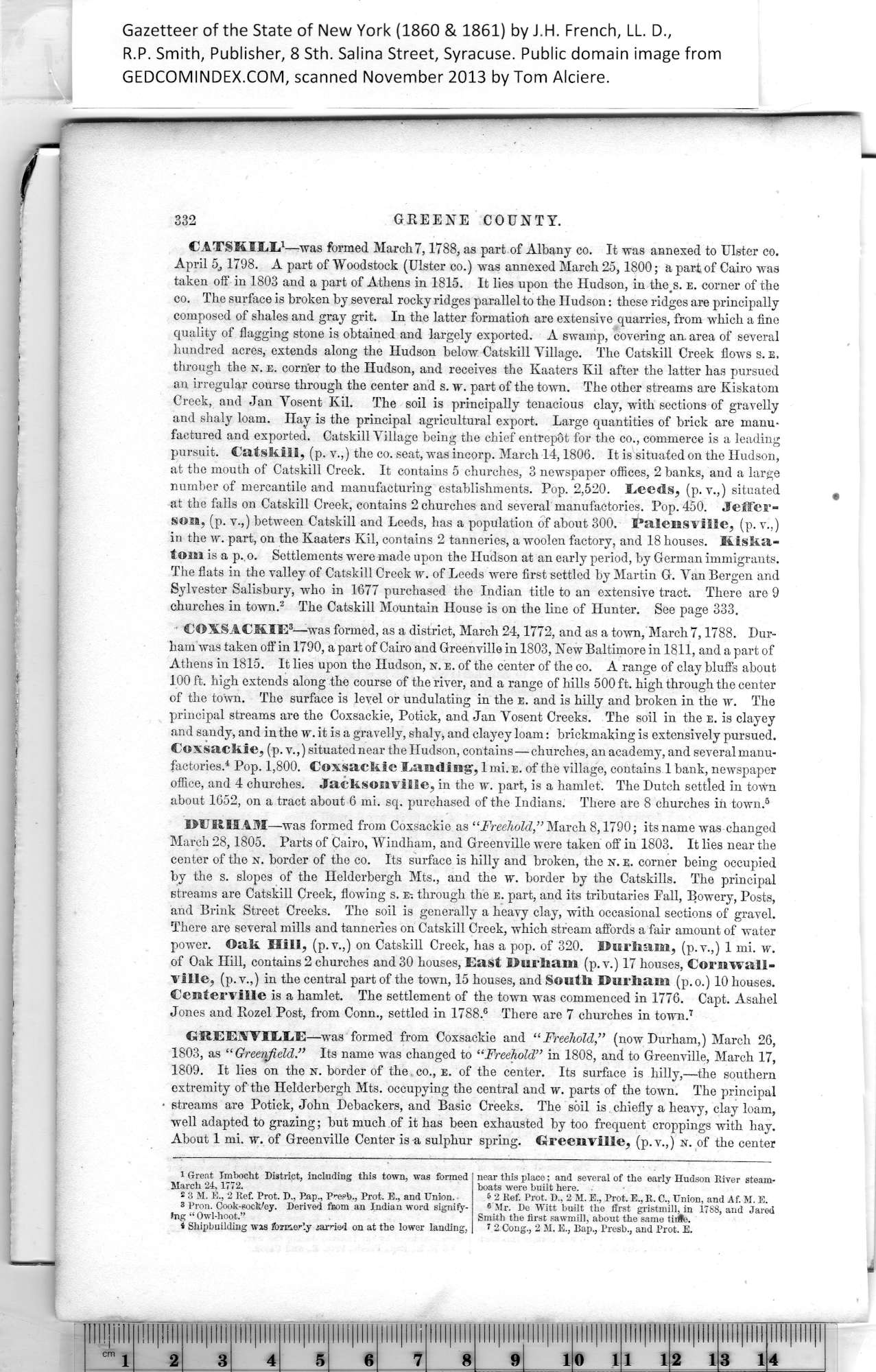|
332 GREENE COUNTY.
CATSMXEE1 —was formed March 7,1788, as part of Albany co. It was annexed to Ulster co.
April 5, 1798. A part of Woodstock (Ulster co.) was annexed March 25,1800; a part of Cairo was
taken off in 1803 and a part of Athens in 1815. It lies upon the Hudson, in the.s. e. corner of the
co. The surface is broken by several rocky ridges parallel to the Hudson: these ridges are principally
composed of shales and gray grit. In the latter formation are extensive quarries, from which a fine
quality of flagging stone is obtained and largely exported. A swamp, covering an. area of several
hundred acres, extends along tbe Hudson below Catskiil Village. The Catskiil Creek flows s. e,
through the n. e. corner to the Hudson, and receives the Kaaters Kil after the latter has pursued
an irregular course through the center and s. w. part of the town. The other streams are Kiskatom
Creek, and Jan Vosent Kil. The soil is principally tenacious clay, with sections of gravelly
and shaly loam. Hay is the principal agricultural export. Large quantities of brick are manu¬
factured and exported. Catskiil Village being the chief entrepot for the co., commerce is a leading
pursuit. Catskiil, (p. v.,) the co. seat, was incorp. March 14,1806. It is situated on the Hudson,
at the mouth of Catskiil Creek. It contains 5 churches, 3 newspaper offices, 2 banks, and a large
number of mercantile and manufacturing establishments. Pop. 2,520. Eeeds, (p.v.,) situated
at the falls on Catskiil Creek, contains 2 churches and several manufactories. Pop. 450. Jeffer¬
son, (p. v.,) between Catskiil and Leeds, has a population of about 300. Paleusville, (p. v.,)
in the w. part, on the Kaaters Kil, contains 2 tanneries, a woolen factory, and 18 houses. Riska-
tom is a p.o. Settlements were made upon the Hudson at an early period, by German immigrants.
The flats in the valley of Catskiil Creek w. of Leeds were first settled by Martin G. Yan Bergen and
Sylvester Salisbury, who in 1677 purchased the Indian title to an extensive tract. There are 9
churches in town.2 The Catskiil Mountain House is on the line of Hunter. See page 333.
COXSACRIE3—was formed, as a district, March 24,1772, and as a town, March 7,1788. Dur¬
ham was taken off in 1790, a part of Cairo and Greenville in 1803, New Baltimore in 1811, and a part of
Athens in 1815. It lies upon the Hudson, n. e. of the center of the co. A range of clay bluffs about
100 ft. high extends along the course of the river, and a range of hills 500 ft. high through the center
of the town. The surface is level or undulating in the E. and is hilly and broken in the w. The
principal streams are the Coxsaekie, Potick, and Jan Yosent Creeks. The soil in the e. is clayey
and sandy, and in the w. it is a gravelly, shaly, and clayey loam: brickmaking is extensively pursued.
Coxsaekie, (p. v.,) situated near the Hudson, contains—churches, an academy, and several manu¬
factories.4 Pop. 1,800. Coxsacliie Eaiiding', 1 mi. e. of the village, contains 1 bank, newspaper
office, and 4 churches. Jacksonville, in the w. part, is a hamlet. The Dutch settled in town
about 1652, on a tract about 6 mi. sq. purchased of the Indians. There are 8 churches in town.6
DURH AM—was formed from Coxsaekie as “Freehold,” March 8,1790; its name was changed
March 28,1805. Parts of Cairo, Windham, and Greenville were taken off in 1803. It lies near the
center of the n. border of the co. Its surface is hilly and broken, tbe n. e. corner being occupied
by the s. slopes of the Helderbergh Mts., and the w. border by tbe Catskills. The principal
streams are Catskiil Creek, flowing s. e^ through the e. part, and its tributaries Fall, Bowery, Posts,
and Brink Street Creeks. The soil is generally a heavy clay, with occasional sections of gravel.
There are several mills and tanneries on Catskiil Creek, which stream affords a fair amount of water
power. Oak Hill, (p.v.,) on Catskiil Creek, has a pop. of 320. Dnrham, (p.v.,) 1 mi. w.
of Oak Hill, contains2 churches and30 houses, East Rurham (p.v.) 17 houses, Cornwall -
ville, (p. v.,) in the central part of the town, 15 houses, and South Durham (p. o.) 10 houses.
Centerville is a hamlet. The settlement of the town was commenced in 1776. Capt. Asahel
Jones and Rozel Post, from Conn., settled in 1788.6 There are 7 churches in town.7
Ci-REENfVIEEE—was formed from Coxsaekie and “Freehold,” (now Durham,) March 26,
1803, as “Greenfield.” Its name was changed to “Freehold” in 1808, and to Greenville, March 17,
1809. It lies on the n. border of the co., e. of the center. Its surface is hilly,—the southern
extremity of the Helderbergh Mts. occupying the central and w. parts of the town. The principal
streams are Potick, John Debackers, and Basic Creeks. The soil is chiefly a heavy, clay loam,
well adapted to grazing; but much of it has been exhausted by too frequent croppings with hay.
About 1 mi. w. of Greenville Center is a sulphur spring. Greenville, (p.v.,) n. of the center
|
near this place; and several of the early Hudson River steam¬
boats were built here.
3 2 Ref. Prot. D., 2 M. E., Prot. E., R. C., Union, and Af. M. E.
6 Mr. De Witt built the first gristmill, in 1788, and Jared
Smith the first sawmill, about the same time.
1 2 Cong., 2 M. E., Bap., Presb., and Prot. E. |
1
Great Imbocht District, including this town, was formed
March 24,1772.
2
3 M. E., 2 Ref. Prot. D., Rap., Presb., Prot. E., and Union.
3
Pron. Cook-soch/ey. Derived fnom an Indian word signify¬
4
ing “ Owl-hoot.”
|
